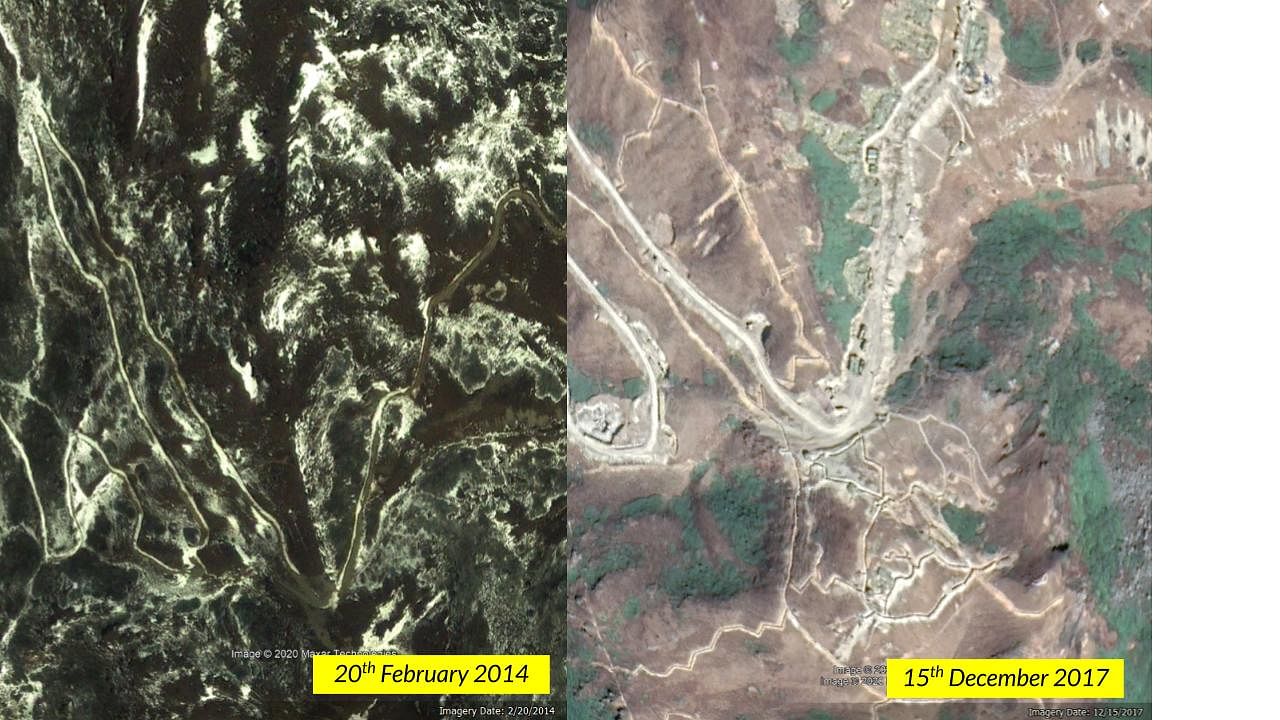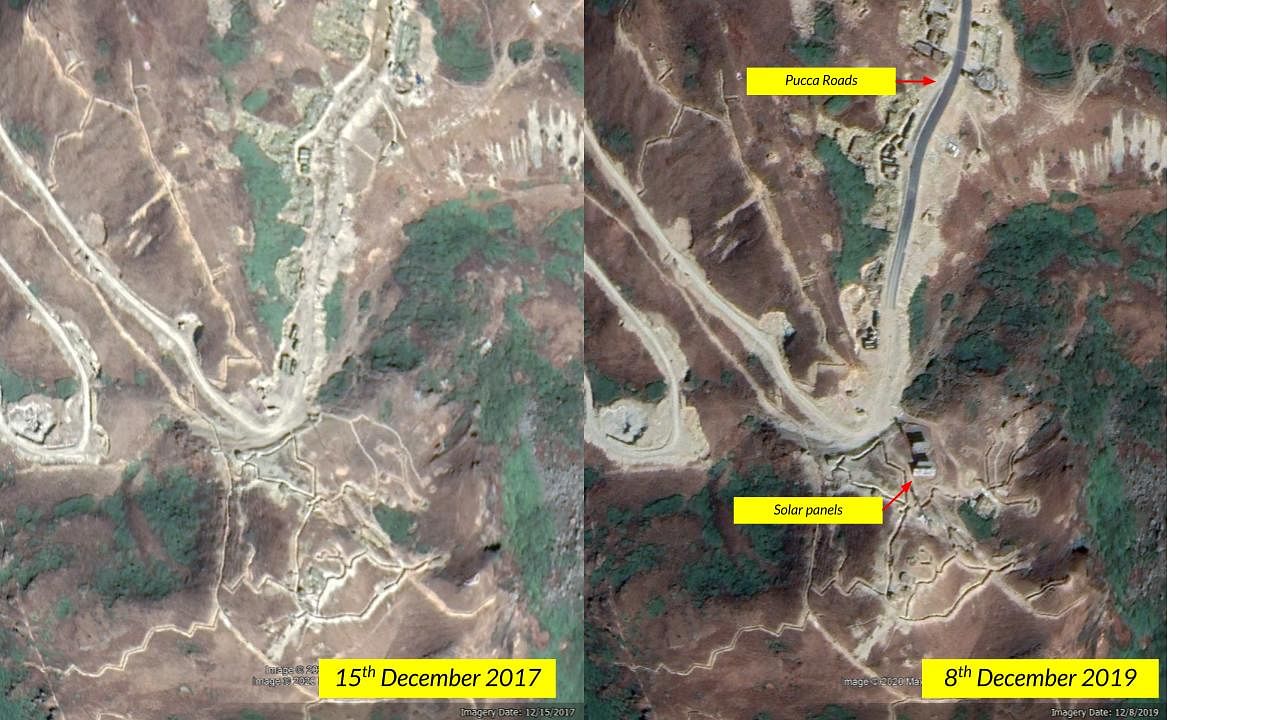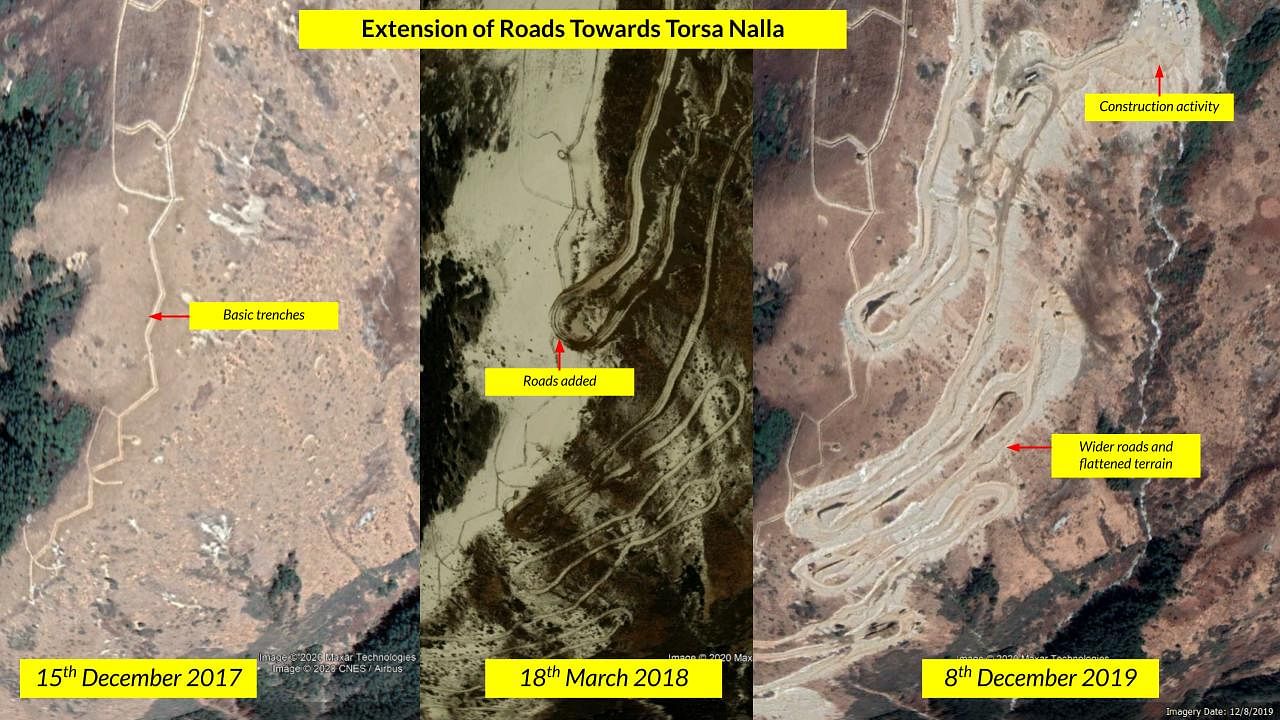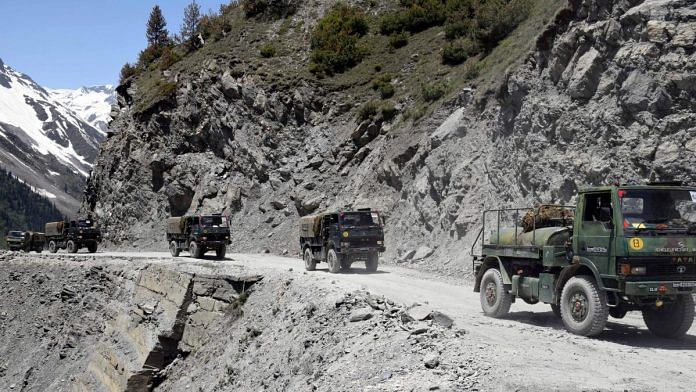Is this going to be another 1962?’ asked my neighbour, an 80-year-old naval veteran. ‘Not at all,’ was my instinctive reply, not because I had any special insight into the ongoing military situation in Ladakh, but because 1962-type wars now linger only in military imagination and tend to get confined largely to the dustbin of history. In reality, due to the shadow of nuclear weapons, the remote possibility of such ‘big fights’ tenant the deterrence space that keeps militaries armed with the state-of-the-art weapons system. They are the substance of political threats, but their military utility is circumscribed to campaign plans.
The relevance of campaign plans lies mostly in the psychological sphere, where the real battles are mind games among opposing political and military leaderships. Territorial conquests that involved entire states have been in decline since 1945. But conquests in lesser forms have persisted. China, in particular, has been perfecting the art of ‘least war prone’ form of conquest for several decades, and its seizure of several patches of territory along the Line of Actual Control (LAC) bears testimony to the Chinese designs, some of which have been highlighted recently by former ambassador and foreign policy expert P. Stobdan.
China’s favourite game
History seldom follows a set pattern. China’s history of territorial conquests falls in the ‘fait accompli’ category. Sparsely populated/unpopulated and undefended territories have been the prime targets, and Chinese moves in East Asia, South China Sea and Sino-Indian border provide ample evidence thereof. Grabbing such territories based on claim lines that were historically fluctuating, and often expanding, has been China’s signature mode. Also, the practice has gained momentum with the growth of China’s power and concurrent internalising of a self-image of surging strength.
The current situation in Ladakh and Sikkim seems to suggest that China is playing its favourite game of seizing disputed territory that is not populated and is not permanently occupied by the border guarding forces. The confrontation in Galwan River valley, Pangong Tso, and Naku La in north Sikkim is sought to be justified as a defensive move by China due to India’s alleged aggressive acts. The official statement of China’s Ministry of Foreign Affairs on 19 May read: “The Indian Army has crossed the line across the western section of the Sino-Indian border and the Sikkim section to enter Chinese territory”.
The fact is that disputed areas exit and have been patrolled by both sides. This has been recognised and agreements signed to avoid confrontations such as the current one.
The 1993 Agreement on the Maintenance of Peace and Tranquility along the Line of Actual Control (LAC) states: “When necessary, the two sides shall jointly check and determine the segments of the (LAC) where they have different views as to its alignment”. However, even 27 years later, China has avoided reconciling the differing perception of the LAC. It only allows China to claim an imagined LAC alignment, which can be exploited to buttress the argument that India is the aggressor.
Also read: Chinese aggression in Ladakh also a message for domestic and external audience: Experts
The victory at Doklam that wasn’t
Over several decades, China’s success in limited territorial grabs has been papered over by several Indian governments, often apparently in the interests of peace and tranquility. The 2017 Doklam stand-off is revealing, even though the territory in question was a matter of dispute between China and Bhutan. India, however, was a party to the dispute because it involved the tri-junction.
The dispute resolution through an agreement that was restricted only to the stand-off site has emboldened China to occupy the rest of the disputed Doklam plateau with military assets, including the creation of permanent roads and military structures. China has, in reality, carried out a blatant aggression of a manifestly disputed territory. But the Narendra Modi government has so far brushed it under the carpet; instead, for the domestic audience, it has managed to sustain the fiction of ‘victory’ at Doklam. The constructions in the area of the Doklam plateau before the confrontation in 2017 and now are revealing.
Roads near Doka La, 2014-2017

Roads near Doka La, 2017-2018

Roads towards Torsa Nalla, 2014-2019

Through its silence, India has acquiesced to China’s military occupation of the Doklam plateau, except of course at the face-off site where the status quo has been maintained. The Indian public has been misled and the media and political opposition have failed to bring out the truth. Like the current stand-off in Ladakh, both sides did not want to escalate the matter in 2017.
But unlike Doklam, where India agreed to withdraw, as long as China did not make the road just below our post at Doka La, the situation is now reversed. China has prevented the movement of our patrols and is concomitantly creating military fortifications where none existed before. It is apparent that China has taken territorial bites in Ladakh, and did so with the claim that it was necessary because India was the aggressor here. Their modus operandi is now familiar. Territorial conquest short of war is evident.
India has moved troops to contain the aggression. Eviction can happen through agreement or force. Use of force is ruled out as an option because India would not like to escalate matters. Instead, it would use the military, diplomatic and political mechanisms at different levels to restore the status quo. But all that depends on China’s objectives and actions.
Also read: Despite Covid, China will spend more on defence in 2020 than it did last year
China has gained
Speculations on China’s intentions and motivations are rife in the Indian media. Notably, unlike the Indian press, apart from some limited coverage by the Global Times, there is no indication of raising the flag of nationalism in China. There is not even a passing mention of it from the political leadership. In the prevailing global and regional strategic context, the current moves on the boundary dispute may not be about the dispute per se but leveraging it to send a message to India about who is the boss. Therefore, any moves to gang up with the West against China should be eschewed. An indication about this is evident in this Global Times article.
India’s deal on Doklam was accompanied by two placatory moves; a change of stance on Tibetans organising a thanksgiving event commemorating the Dalai Lama’s 60 years of exile, and the cancellation of a seminar at the Institute for Defence Studies and Analyses (IDSA). It was followed by an attempted reset of relations signified by the Wuhan and Mamallapuram spirit. Overall, India’s approach failed the smell test of appeasement and China probably took note of it.
This time, small military bites in two places also give China more bargaining power and Beijing could be hoping that at the end of the current confrontation, which will not result in a war, the status quo could be changed in at least one place and restored in the other. China then gets to send the message across and gains marginally in territory. It is to this game plan that India must play.
Also read: India to seek ‘amicable solution’ with China amid military build-up on LAC
Choices for Indian military and political leadership
The role of India’s military forces is confined to containing the expansion of China’s territorial control in the confrontation areas. That role is relatively easy to undertake because China does not intend to expand. But it will want to keep what it has already bitten off, and use the time to build military fortifications, including roads a la Doklam. The intensity of this could vary in confrontation areas and Galwan might be what China wants to keep because of its proximity to the Darbok-Shyok-DBO road.
The political question is whether China has crossed India’s Lakshman rekha and whether certain steps to increase India’s bargaining power should be taken before serious diplomatic and political talks are undertaken. In my view, it certainly has, because China’s moves are synonymous to military occupation, though its scale is limited. No vital interest of India is directly threatened but its vital interest of strategic autonomy could be under indirect threat. China is trying to influence India’s decision-making in the context of the US-China geopolitical competition. It’s assumption springs from its experience in Doklam that India can be pressured.
The test for the Modi government is: what measures must it take to increase India’s bargaining power with China? These can be both nuanced and explicit, and range from a military quid pro quo that involves small bites to signalling change of stance in our relations with other powers that could include Tibet, Taiwan, Quad Plus, the US and so on.
Amid an expanding pandemic and a devastated economy, India must treat the situation as a Lakshman rekha having been crossed but do so quietly and not beat the nationalist drums, which is the natural proclivity of the media. More importantly, it must not be self-deluded that diplomatic virtuosity can alone handle the situation. Political sagacity and boldness are the need of the hour.
Lt Gen (Dr) Prakash Menon is Director, Strategic Studies Programme, Takshashila Institution, Bengaluru; and former military adviser in the National Security Council Secretariat. He is the author of Strategy Trap: India & Pakistan Under the Nuclear Shadow. Views are personal.




Sad to read an inaccurate article like this with satellite photographs ( which shows god knows what) and unknown, unnamed sources as the basis. The facts stated by the author about the ground position are clearly wrong. We can trust our army.
China will not directly coming to war. They plan to hit by other neighboring countries. So be alert!
China mainly disappointed due to our updated investment rule. They are not directly coming to war, they know 20% of economy is based on Indian market. So they plan for mock war but the real war begins from other neighboring country. So we need to rethink all the aspects and tighten all the borders carefully.
Territories are nothing but pseudo lines. We should not fight for which is not much of relevance. It’s a good move of government if they are doing through dialogue and not fight. I am not expecting from this government that they will do that. But may god gives them brain and not fight. Let china takes 2 or 3 km if they want.
India should not fall into a trap of blackmailing of China for supporting its Genocide corridors in return of Doka La.
China is furious & doing all this with India & Bhutan because both the countries has strongly opposed its Genocide corridors – OBOR in June 2017.
India should & must not support TKB- Tibet Kashmir Baluchistan Genocide Corridor or CPGC- China Pakistan Genocide Corridor or so called CPEC/OBOR (One Belt One Road)/BRI (Border Road Initiative).
These areas i.e., Tibet, Kashmir, Kailash Mansarover,Himalayas, Baluchistan are anciently & historically integral part of India.
A terrorist Mao regime or Mao Republic of China since 1950’s first killed there own King, than its own people and afterwards start capturing Indian northern areas & demolishing peoples fundamental rights & even conducting mass genocides from Tibet to Chinese Occupied Kashmir (Aksai Chin) & now from Gilgit Baltistan to Baluchistan.
Moreover Mao’s Communist regime of China does not even care to obey/respect International Rules & Regulations, whether it is in case of supply of Nukes & its Technology to North Korea, Pakistan & through Pakistan to Iran, Iraq & Libya. And more recently whether we look in the case of Vietnam Sea (or so called South China Sea), strict violation of the orders of International Court of Justice by China. On regular basis China even violates the territorial boundaries (either water or land) of other neighbouring countries like Taiwan, Tibet, Mongolia, Brunei, Philippines, Japan, South Korea, Malaysia, Indonesia, Singapore, Hong Kong, Macau, Vietnam, India, Bhutan etc.
In China there are no democratic rights for there own people. People in China does not even have a right to vote, but it is hard to understand why it is called as People’s Republic of China.
This is not a forwarded message.
Written exclusively by Amit*
Reply by a Military Man as above given.
This Comment, I find Most appropriate.
indian (Modi )Government is trying to fix up many issues Pending with the Country.
My View as a Simple man is also as per view of this Military Veteran.
The Government, now, is already making itself Strong so as to reply all the Enemies of the country within as well as outside known .
Copy of comment as above from the Military Veteran :
A ground reality concluded in well equipped Article by the Writer that Political Sagacity & boldness are the need of hour by India against China.
With due respect,I,wish to add that Small Bites regularly taken by Dragon since 1962, are nothing BUT , his , Military Occupations , Fortifications & I’ll designs, on in question LAC & *earliest they are Stopped,the Best.*
Th Government is being too weak and timid. The West is moving manufacturing out of China and the Chinese keep taking Indian territory. it is an absolute joke that they are able to get away with this!
Now is the time to be tough on China. Conciliatory moves are a pure waste of time with bullies. China is the biggest bully in this region. Modi and his team are being much too weak against the CCP (and now based on the information in this article apparently seemed so in the past also!).
Options: Threaten the dictator Xi and his PLA drones: China only respects force. Do you think the Chinese would have set back if the roles and actions were reversed? Indian government reeks of weakness by trying to solve without invading parts of China (tit for tat)!
1) Bring in the Americans for a mutual base to be established all over the LAC and we shall do so, if they refuse to get out of our lands – immediately. We are prepared to go to war and lets see how long the Chinese can keep their manufacturing base?
2) Recognize Taiwan and threaten the CCP that Taiwan may well get access to Nuclear technology – the way the CCP gave it to Pakistan.
3) Support for a free Tibet through this invasion of India.
4) Recognize and support of the HK democratic movement along with the West. Why remain muted as the world’s largest Democracy.
5) Support for the 1 Million Uighurs in detention camps.
5) Bring in double the troops (including bulldozers, artillery, etc) to China and start making it a global and serious incident. Most in the world will support India and in many ways. It will hasten the departure of manufacturing out of China immediately. China has more to lose by making this a major global issue, rather than remaining so neutered! ”
Walk softly but carry a big stick”
Modi and his team really need to put their backs on this one and seriously draw the line in the sand to the Dictator and criminal Xi and his PLA drones.
It cannot continue like this! This is not 1962.
The same thought we had in 62 …and we all know what happened .
The UN works for the victor . So dont expect any help from them..
Get ready for a full blown war OR just let them walk in quitely snd take what they wsnt .
If the Chinese has transgressed 3 kms into the Indian territory, they should be shot dead. Why do we even wait?
Yes
So long India relies on its brave manpower more than it relies on war machines, war logistics etc it will remain subservient. The Chinese do not respect politeness. Or weakness. Was the Army sleeping when the first movements went undetected? If they had been stopped when the first recce platoon was breaching the border now India won’t have to deal with an encampment. How lazy and how negligent this is? Heads must roll!
India has a long border with China. Not immediately but within a year or two can India grab some land in some other area from China? I mean that makes the most logical sense to me as it seems nobody wants war and it’s so difficult to push somebody out that whoever gets in, stays. Plus this was a planned operation from China, how did we let this happen? How can a bunch of Chinese soldiers come in, physically lay claim after just a fist fight. This seems so easy. Local commanders must me given permission to act quickly – may be we could send patrols behind the Chinese lines, create snore fist fights, etc – how can we get settled into this situation so easily and so quickly?
One can understand India succumbing to China’s aggression in 1962, as India was militarily weak under a pacifist leader. Now, it is no longer the case. India is militarily strong, though the strength of military and hardware may not be match. Then why is Modi government so timid in its responses to China, and make Indians believe that it has won the eye-ball contest? I think the public and opposition parties should be more alert and hold the government accountable.
Indian bravery is a mirage created by Indian media. India want to extract benefits from China- America friction without any concrete commitments. But pentagon isn’t occupied by fools. The war is inevitable. Either fight alongside allies and triumph or get humiliated by China. Banya schemes only work against unarmed minorities. In the end media will fool the public into believing an non existent victory with very little loss of territory and dignity.
Sir is it that since China has gained subsequent territory in Ladakh has a bargaining chip to keep some of it and maintain status quo on the other as you said, cant we garner our support from international community or may be can go on an offensive because if they have crossed the Lakshman Rekha it is a matter of sovereignity which has been compromised by the Chinese?
HUAWEI should be publicly denounced as a future trojan horse weapon being planned by China.
A ground reality concluded in well equipped Article by the Writer that Political Sagacity & boldness are the need of hour by India against China.
With due respect,I,wish to add that Small Bites regularly taken by Dragon since 1962, are nothing BUT , his , Military Occupations , Fortifications & I’ll designs, on in question LAC & earliest they are Stopped,the Best.
It is not clear without knowing actual ground position at site for common citizen like us because it is a complex issue but one thing is it is crystal clear that who is powerful militarily would always dictate it’s terms to adversaries so India must advance and modernize military establishment and must make continuous efforts to be self reliant and self production of military supplies which would create job and industrial growth.If needed Govt. of India should promote some private companies to bolster production of much advanced and sophisticated appliances in India which could benefit country.India need to spend on more defense budget.
With due respect to the author, I must point out that what has been stated about Doklam is incorrect. I have no intention of saying anything further on it in this platform, as a responsible person. But I would suggest that due research is done before putting out facts about such issues
As a lay person, with the benefit of hindsight, would it be fair to say that the intervention in Doklam,, without an explicit request from Bhutan, has done more harm than good.
Hey chinese troll, get out of here
India must do surgical strike china china
China enjoys an advantage with India silently acquiescing to its acquisition of our legitimate lands over the years of comprador rulers of past who just did nothing.
So present rulers will show their true selves and have to deal . If they deal as national bourgeoisie then India has hopes; if they deal as comprador, here today gone tomorrow types of the past rulers, then we are gone for a toss.
Lots f issues this Modi Govt has to face and reveal its true colors to Indian People. The march and suffering of the migrant labor cannot be forgotten easily by those who marched.
However, protecting the entire Doklam Plateau was never the aim of the army. It was the southern expansion towards the Indian border that was a point of concern. The Doklam dispute is between Bhutan and China akin to the Aksai Chin dispute between India and China. Although disputed it was under the control of China and hence they continued construction activities. Only this times they have turned hypocrites demanding that India stop construction in what it considers disputed territory but is under Indian control. Prolonged Indian presence at Doklam would have just hurt our relationship with the Bhutanese public as a New York article stated that Doklam was not a great matter of concern for the local crowd. Rather they were afraid of being caught in a tussle between China and India and suffer Tibet’s fate.